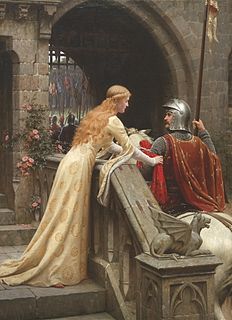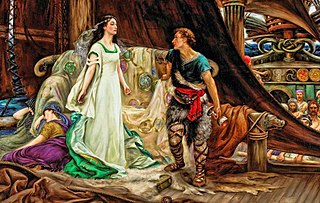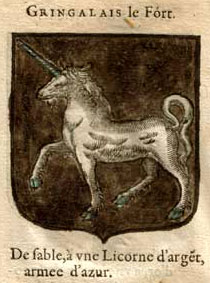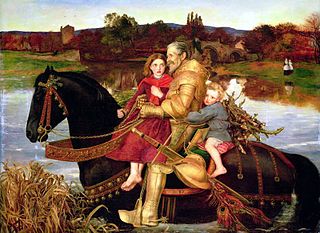
Sir Gawain and the Green Knight is a late 14th-century chivalric romance in Middle English. The author is unknown; the title was given centuries later. It is one of the best-known Arthurian stories, with its plot combining two types of folk motifs: the beheading game, and the exchange of winnings. Written in stanzas of alliterative verse, each of which ends in a rhyming bob and wheel; it draws on Welsh, Irish, and English stories, as well as the French chivalric tradition. It is an important example of a chivalric romance, which typically involves a hero who goes on a quest which tests his prowess. It remains popular in modern English renderings from J. R. R. Tolkien, Simon Armitage, and others, as well as through film and stage adaptations.

Courtly love was a medieval European literary conception of love that emphasized nobility and chivalry. Medieval literature is filled with examples of knights setting out on adventures and performing various deeds or services for ladies because of their "courtly love". This kind of love is originally a literary fiction created for the entertainment of the nobility, but as time passed, these ideas about love changed and attracted a larger audience. In the high Middle Ages, a "game of love" developed around these ideas as a set of social practices. "Loving nobly" was considered to be an enriching and improving practice.

Bevis of Hampton or Sir Bevois, was a legendary English hero and the subject of Anglo-Norman, Dutch, French, English, Venetian, and other medieval metrical chivalric romances that bear his name. The tale also exists in medieval prose, with translations to Romanian, Russian, Dutch, Irish, Welsh, Old Norse and Yiddish.

As a literary genre of high culture, heroic romance or chivalric romance is a type of prose and verse narrative that was popular in the noble courts of High Medieval and Early Modern Europe. They were fantastic stories about marvel-filled adventures, often of a chivalric knight-errant portrayed as having heroic qualities, who goes on a quest. It developed further from the epics as time went on; in particular, "the emphasis on love and courtly manners distinguishes it from the chanson de geste and other kinds of epic, in which masculine military heroism predominates."
Sir Launfal is a 1045-line Middle English romance or Breton lay written by Thomas Chestre dating from the late 14th century. It is based primarily on the 538-line Middle English poem Sir Landevale, which in turn was based on Marie de France's lai Lanval, written in a form of French understood in the courts of both England and France in the 12th century. Sir Launfal retains the basic story told by Marie and retold in Sir Landevale, augmented with material from an Old French lai Graelent and a lost romance that possibly featured a giant named Sir Valentyne. This is in line with Thomas Chestre's eclectic way of creating his poetry.

Tristan and Iseult is a chivalric romance retold in numerous variations since the 12th century, with a lasting impact on Western culture. The story is a tragedy about the illicit love between the Cornish knight Tristan (Tristram) and the Irish princess Iseult. It tells of Tristan's mission to escort Iseult from Ireland to marry his uncle, King Mark of Cornwall. On the journey home, the two of them ingest a love potion which brings about the adulterous relationship.

Sir Gingalain, also known as Le Bel Inconnu, or The Fair Unknown, is a character from Arthurian legend whose exploits are recorded in numerous versions of a popular medieval romance. His nickname differs depending on the version and language; he is known in English as Libeaus Desconus. He is the title character in Le Bel Inconnu, a poem composed by Renaut de Beaujeu sometime between the mid-1180s and 1230, and in the (destroyed) 13-century manuscript, Gliglois. It is uncertain, however, if the Gliglois of the medieval manuscript refers to Gawain's son or some other character in the "Fair Unknown" cycle.

Sir Isumbras is a medieval metrical romance written in Middle English and found in no fewer than nine manuscripts dating to the fifteenth century. This popular romance must have been circulating in England before 1320, because William of Nassyngton, in his work Speculum Vitae, which dates from this time, mentions feats of arms and other 'vanities', such as those found in stories of Sir Guy of Warwick, Bevis of Hampton, Octavian and Sir Isumbras. Unlike the other three stories, the Middle English Sir Isumbras is not a translation of an Old French original.
Cligès is a poem by the medieval French poet Chrétien de Troyes, dating from around 1176. It is the second of his five Arthurian romances; Erec and Enide, Cligès, Yvain, Lancelot and Perceval. The poem tells the story of the knight Cligès and his love for his uncle's wife, Fenice.

Gerald FitzMaurice FitzGerald (1335–1398), also known by the Irish Gaelic Gearóid Iarla, was the 3rd Earl of Desmond, in southwestern Ireland, under the first creation of that title, and a member of the Hiberno-Norman dynasty of the FitzGerald, or Geraldines. He was the son of Maurice FitzGerald, 1st Earl of Desmond, by his third wife Aveline (Eleanor), daughter of Nicholas FitzMaurice, 3rd Lord of Kerry. He was half-brother to Maurice FitzGerald, 2nd Earl of Desmond.
Melion is an anonymous Breton lai that tells the story of a knight who transforms into a werewolf for the love of his wife who betrays him.
The Squire of Low Degree, also known as The Squyr of Lowe Degre, The Sqyr of Lowe Degre or The Sqyr of Lowe Degree, is an anonymous late Middle English or early Modern English verse romance. There is little doubt that it was intended to be enjoyed by the masses rather than the wealthy or aristocratic sections of society, and, perhaps in consequence of this, it was one of the better-known of the English romances during the Elizabethan and Jacobean eras, and again in the 19th century. There are three texts of the poem: it was printed by Wynkyn de Worde c. 1520 under the title Undo Youre Dore, though only fragments totalling 180 lines survive of this book; around 1555 or 1560 another edition in 1132 lines was produced by William Copland; and a much shorter version, thought to have been orally transmitted, was copied into Bishop Percy's Folio Manuscript around the middle of the 17th century. The precise date of the poem is unknown, estimates varying from 1440 to 1520, but Henry Bradley's date of c. 1475 has been quite widely adopted. Standing as it does at the very end of the English Middle Ages it has been called "a swan song of the romance".

The Anglo-Norman romance Ipomedon by Hue de Rotelande, composed near Hereford around 1180, survives in three separate Middle English versions, a long poem Ipomadon composed in tail-rhyme verse, possibly in the last decade of the fourteenth century, a shorter poem The Lyfe of Ipomydon, dating to the fifteenth century and a prose version, Ipomedon, also of the fifteenth century. In each case, the story is taken independently from the Anglo-Norman romance Ipomedon, written in Old French by Hue de Rotelande "not long after 1180", possibly in Herefordshire, England. It is included in a list of the popular English romances by Richard Hyrde in the 1520s.

Sir Gowther is a relatively short Middle English tail-rhyme romance in twelve-line stanzas, found in two manuscripts, each dating to the mid- or late-fifteenth century. The poem tells a story that has been variously defined as a secular hagiography, a Breton lai and a romance, and perhaps "complies to a variety of possibilities." An adaptation of the story of Robert the Devil, the story follows the fortunes of Sir Gowther from birth to death, from his childhood as the son of a fiend, his wicked early life, through contrition and a penance imposed by the Pope involving him in a lowly and humiliating position in society, and to his eventual rise, via divine miracles, as a martial hero and ultimately to virtual canonization. But despite this saintly end, "like many other lays and romances, Sir Gowther derives much of its inspiration from a rich and vastly underappreciated folk tradition."

Sir Eglamour of Artois is a Middle English verse romance that was written sometime around 1350. It is a narrative poem of about 1300 lines, a tail-rhyme romance that was quite popular in its day, judging from the number of copies that have survived – four manuscripts from the 15th century or earlier and a manuscript and five printed editions from the 16th century. The poem tells a story that is constructed from a large number of elements found in other medieval romances. Modern scholarly opinion has been critical of it because of this, describing it as unimaginative and of poor quality. Medieval romance as a genre, however, concerns the reworking of "the archetypal images of romance" and if this poem is viewed from a 15th-century perspective as well as from a modern standpoint – and it was obviously once very popular, even being adapted into a play in 1444 – one might find a "romance [that] is carefully structured, the action highly unified, the narration lively."
Sir Tryamour is a Middle English romance dated to the late fourteenth century. The source is unknown and, like almost all of the Middle English romances to have survived, its author is anonymous. The 1,719-line poem is written in irregular tail rhyme stanzas composed in the Northeast Midlands dialect. There are textual ambiguities and obscurities that suggest corruption or "loose transmission." Consequently, interpretations, glosses and notes vary between editions, sometimes substantially.
Amoryus and Cleopes is a poem written in 1449 by John Metham; it was an early English adaptation of the Pyramus and Thisbe narrative from Book 4 of Ovid‘s Metamorphoses.
The Lincoln Thornton Manuscript is a medieval manuscript compiled and copied by the fifteenth-century English scribe and landowner Robert Thornton, MS 91 in the library of Lincoln Cathedral. The manuscript is notable for containing single versions of important poems such as the Alliterative Morte Arthure and Sir Perceval of Galles, and gives evidence of the variegated literary culture of fifteenth-century England. The manuscript contains three main sections: the first one contains mainly narrative poems ; the second contains mainly religious poems and includes texts by Richard Rolle, giving evidence of works by that author which are now lost; and the third section contains a medical treatise, the Liber de diversis medicinis.
Sir Degaré is a Middle English romance of around 1,100 verse lines, probably composed early in the fourteenth century. The poem is often categorised as a Breton lai because it is partly set in Brittany, involves an imagined Breton royal family, and contains supernatural elements similar to those found in some other examples, such as Sir Orfeo. Sir Degaré itself does not explicitly claim to be a Breton lai. The poem is anonymous, and no extant source has ever firmly been identified.
The Folie Tristan d’Oxford, also known as the Oxford Folie Tristan, The Madness of Tristan, or Tristan’s Madness, is a poem in 998 octosyllabic lines written in Anglo-Norman, the form of the Norman language spoken in England. It retells an episode from the Tristan legend in which Tristan disguises himself as a madman to win his way back to Ysolt. The poem can be dated to the period 1175–1200, but the name of the author is unknown. It is not to be confused with the Folie Tristan de Berne, a different medieval poem on the same subject, each work taking its name from the city in which the manuscript is now kept.










